
Atlas F1 Senior Writer
He is the only native-born American to have ever become a Formula One World Champion and after a long and varied career successfully racing everything on wheels, he has only one regret: that he never had a chance to run Indy. But Hill, still spry, energetic and active at 74 years old, will be at Indianapolis this weekend also celebrating the 40th Anniversary of his victory at the 1961 Italian Grand Prix, when he brought Ferrari its first Constructors' Championship and himself the 1961 World Drivers' Championship. Thomas O'Keefe tells the story of this remarkable driver
But it would not be long before young Phil Hill was racing himself, first an Offy midget at the San Bernadino, California dirt track and later an MG TC at Gardena's half mile track, his first sports car. By 1949, when he was 22 years old, he had made his way from California to England by means of trains and an Atlantic crossing by ship, to be greeted and picked up in England at the Leamington Spa railroad station by Lofty England, Jaguar's motor racing chief, who arranged a new Jaguar XK120 for Phil.
Phil Hill ultimately ended up taking the XK 120 back to California where Hill campaigned the car successfully throughout the 1950 season, winning the first Pebble Beach road race while nursing his Jaguar home without a clutch. Indeed, in the course of his career, Phil Hill was a winner in virtually every major sportscar race.
By the time he joined the ranks of Grand Prix drivers, Hill had won the 12 Hours of Sebring (he would win it two more times in his career), Le Mans (which he also ultimately won three times and was the first American winner) and the 1955 Bahamas Speed Weeks race as well as finishing an impressive second in the 1954 version of the grueling Mexican road race called the Carrera Panamericana in a Ferrari 375 MM. In 1957, he won the season-ending race in Caracas, Venezuela, clinching the Manufacturer's Sports Car Championship for Ferrari. Also in South America, Hill won the Argentine 1000 km three times. After driving Ferrari sports cars for the factory team at many of these venues, Enzo Ferrari gave Phil his shot at driving a Ferrari Formula One car in 1958, when he joined the team for three critical Grands Prix.
1958: A Season of Death and Team Orders
At the time of Phil Hill's first Grand Prix in a Ferrari, Mike Hawthorn - Ferrari's lead driver - was engaged in a nip and tuck battle for the 1958 World Championship with his fellow Englishman and arch-rival Stirling Moss, who was then driving for Tony Vandervell's Vanwall team - the leading British marque that year. The two Englishmen had contrasting styles, both as drivers and as people, with Hawthorn known to be a swashbuckling, carefree, fun-loving sort who could be a bit rough on the track and Moss thought to be a more cerebral type who was all business when it came to racing, but a gentleman at all times, on and off the track.
As of the German Grand Prix at Nurburgring (held at the old 14.17 mile Nurburgring with 176 corners and a 9 minute lap time), when Phil Hill joined the fray, there were only four races left in the season. Moss had won two of the previous races, the Argentine Grand Prix in the nimble, rear-engined Cooper and the Dutch Grand Prix in his usual race car, the front-engined Vanwall. Hawthorn had won at Rheims in France in his front-engined Ferrari Dino 246, but had finished in the points more often than Moss throughout the season, keeping the Championship a seesaw battle. Hawthorn's victory at Rheims had come at a high price for the Ferrari team however, as Luigi Musso, Hawthorn's Italian teammate, crashed while challenging Hawthorn for the lead, later dying in hospital of his injuries. As Enzo Ferrari said afterwards: "I have won at Rheims but the price is too high. I have lost the only Italian driver who mattered in Formula One racing."
At Nurburgring, all Ferrari had available for Phil Hill was second-tier equipment, a Ferrari Dino 156, in effect a 1.5 litre Ferrari Formula 2 car, and yet Hill finished in 9th spot. But the race was another disaster for the Ferrari team as yet another of its drivers, this time Englishman Peter Collins, was killed while battling with ultimate winner, Tony Brooks, in his Vanwall. Both Moss and Hawthorn finished out of the points, but the death of the two drivers in two races had stunned the Ferrari team.
Enter Phil Hill, as a Johnny-on-the-spot. Earlier in 1958, at LeMans, Phil Hill has won the first of his three Le Mans victories in a Ferrari 250 Testa Rossa V12, under horrendous conditions of torrential rain. Although a relative rookie in Grand Prix racing, at 31 years old, Hill was regarded by Enzo Ferrari as mature, reliable and fast and became the pivotal "Go To" guy at Ferrari in the last two races of the 1958 season, the Italian Grand Prix at Monza and the Moroccan Grand Prix, to be held at Casablanca.
Hill finally got his hands at Monza on the Ferrari Dino 246 that Hawthorn and von Trips had all through the 1958 season. Ferrari and Vanwall both put on a show of force at Monza. Four Ferrari 246s were entered for Hawthorn, von Trips, Phil Hill and Olivier Gendebien. Gendebien had been Hill's co-driver in winning Le Mans that year. Vanwall entered three cars for Stirling Moss, Tony Brooks and Stuart Lewis Evans and Moss qualified on pole; his Vanwall teammate Tony Brooks was beside him and the Ferrari of Mike Hawthorn ended up in the third spot on the front row. Amazingly, at the start, it was relative newcomer Phil Hill that went through from the second row of the grid and took the early lead for laps 1 through 4, succeeded by Moss as Hill fell back. Brooks stayed in shouting distance of the leaders back in fourth place, behind Moss, Hill and Hawthorn. Moss led until lap 15, going out with gearbox trouble on lap 17. Hawthorn took over the lead after Moss retired.
But by lap 57 of the 70 lap race, Brooks in the Vanwall was gaining steadily on Hawthorn, who, with Moss out and himself finally in first place, was looking like a winner. Then, mechanical gremlins struck: Hawthorn's clutch began to slip and Brooks was able to catch and pass Hawthorn in front of the Grandstands on lap 60 and went on to take the win for Vanwall, 20 plus seconds ahead of Hawthorn at the flag. And what of Phil Hill? It is clear from the record that Phil Hill was in rare form that day in his Ferrari 246, having set fastest lap and led the race for laps 1 to 4 and laps 35 to 37; but, at the flag Phil Hill was only in third, four seconds behind Hawthorn, who was limping home to second with his slipping clutch. Hill had clearly slowed down pursuant to Ferrari team orders to allow Hawthorn to score valuable points to keep his Championship hopes alive.
As the teams prepared to send their cars from Europe to North Africa in mid-October 1958 for the last race of the season at Casablanca, both the Drivers and Constructors Championships were on a knife edge and could go either way, depending on the outcome of the Moroccan Grand Prix. Hawthorn had 40 points and Moss had 32 points. Under the system that prevailed at that time, first place was awarded 8 points, second place 6 points and third place 4 points. There was also a point for fastest lap. Because only a driver's best six finishes would count for the championship, Moss's situation left him with only one option if he wanted to win the World Drivers' Championship: he must win the Casablanca race and set fastest lap and hope Hawthorn did not finish second.
On race day the weather in Casablanca was sunny, mild and dry on the fast and demanding circuit. Hawthorn had put his Ferrari on pole and Moss was right next to him on the front row. Moss did all he had to do that day to win both the Drivers' and Constructors' World Championships. He led the 53 lap race from the outset, he set fastest lap and he won the race by a margin of over 80 seconds on a 4.73 mile circuit where it took 2 minutes and 20 seconds to do a lap.
Behind Moss on the track would have been Phil Hill's Ferrari (Phil had qualified fifth and was having another good day) but Ferrari team orders intervened once again and Hill moved over to let his teammate Hawthorn by for second place, which allowed Hawthorn to take sufficient points to win the Drivers Championship from Moss by exactly one point, 42 to 41. The record books show that the gap from Hawthorn to Hill was 0.8 of a second. This outcome meant that it was to Hawthorn not to Moss that the honor would go of being the first Englishman to become a Formula One Drivers' Champion, and in a very real sense Hawthorn owed that honor to Phil Hill, whose unselfish and sportsmanlike deference made it all possible.
Ironically, although Mike Hawthorn was a winner that day in mid-October 1958 in North Africa and became World Champion, he was to die just three months later in January 1959 in a road accident in England.
1959 and 1960: A Winner Becomes a Dinosaur
But even the finest team leader could not take the Ferrari team too far in the next two seasons which were to belong to Cooper-Climax and its driver, Jack Brabham. The rear-engined revolution that Stirling Moss had begun back in Argentina in January 1958 in Rob Walker's Cooper-Climax was now fully underway, leaving the beautiful but bulbous and beefy front-engined Ferrari Dino 246s in their wake.
Ferrari did manage to win the German Grand Prix at the fast and dangerous Avus banked track in Berlin, where Brooks, Gurney and Hill finished 1, 2 and 3. But Hill won no races in 1959 and the only other Ferrari team finish worth mentioning was the victory of Tony Brooks at the 1959 French Grand Prix, where Phil Hill finished second. Even at the 1959 Italian Grand Prix at Monza, where Ferrari emptied out the factory and fielded an astonishing five cars the best they could do was a second by Phil Hill, Stirling Moss in his Cooper-Climax finishing in first place.
Gallingly, even on Phil Hill's home ground, the inaugural US Grand Prix at Sebring on December 12, 1959, the three Ferraris sent over for Hill, Brooks and von Trips could not best the little Coopers; ending a miserable year, Phil Hill was out of the race after only 8 laps with clutch problems, on a racetrack he always dominated in the Sebring 12 hour races.
1961: Church Bells Ring at Maranello
These days, when Formula One has no American drivers, it is surprising to reflect that the day Phil Hill won his World Championship at Monza in 1961, there were no less than four Americans in the race, two of them - Richie Ginther and Hill - driving for Ferrari. Indeed, fellow Californian Dan Gurney finished second to Hill that day at the Italian Grand Prix in his air-cooled flat four Porsche 718. Masten Gregory was the senior American of this foursome but went out early in the race when his Lotus-Climax developed suspension problems.
In 1961, Hill and Ginther had the good fortune to be in the legendary rear-engined "Sharknose" Ferrari Tipo 156 (the "156" designation stood for the 1.5 litre V6 engine), with its sleek and distinctive looking twin-nostril treatment on the car's low-slung nose and the aerodynamic louvered and swept back tail at the rear of the car. Chrome wire wheels, clear plexiglass covers over the carburetors and air scoops here and there completed the picture and created a racy profile.
In those days, there were only eight Grands Prix that counted for the Formula One World Championship, as compared to seventeen races today. Monaco was typically the first Grand Prix on the calendar and was run that season on May 14th 1961. Ferrari fielded three Sharknose 156s for Hill, Ginther and Wolfgang von Trips, a German aristocrat and Germany's most successful Grand Prix driver until Michael Schumacher came along. But Stirling Moss, in an outdated rear-engined privateer Lotus 18, drove a spectacular race and vanquished all challengers, first Phil Hill, and then Richie Ginther, ultimately winning by a 3.6 second margin over Ginther's Ferrari. Phil Hill and von Trips finished third and fourth so it was a disappointing but nonetheless promising start for the Sharknose.
As the season unfolded, the Sharknose 156s began to demonstrate their dominance in a series of Grands Prix. At Zandvoort for the Dutch Grand Prix, Phil Hill took pole position and von Trips and Phil Hill were 1, 2 in a remarkable race where all 15 cars that started the race finished and there were no pitstops and no accidents. Only Jim Clark in his Lotus 21, who finished third and set fastest lap could do battle with the Sharknose Ferrari's.
In the Belgian Grand Prix at the majestic Spa-Francorchamps circuit in the Ardennes forest, the Ferrari four-car works team circulated at the head of the grid, paring off in twos and racing one another during the race and finishing 1, 2 3 and 4, with Phil Hill in first place ahead of von Trips. Richie Ginther was third and Belgian Olivier Gendebien drove his trademark Belgian yellow Sharknose 156 which brightened up the grid.
In the French Grand Prix at Rheims, rookie Giancarlo Baghetti in a privateer Sharknose 156 won his very first Championship Grand Prix, something no one else has ever done, after a thrilling slipstreaming duel with the Porsche 718 of Dan Gurney which featured constant swapping of the lead that only ended on the last turn of the final lap when the stone-battered nose of Baghetti's Sharknose edged out Gurney by a 0.1 second margin. Phil Hill had again been on pole and set fastest lap but could only finish ninth; von Trips went out with engine problems, as did Ginther. Jim Clark's Lotus 21 finished third.
The next race was the German Grand Prix, where the Ferrari team hoped to show well as it was von Trips' home race and by this time he was a national hero in Germany. Who was Wolfgang Graf Berghe von Trips? At the distance of 40 years, it is hard for us to appreciate the importance of Count Wolfgang "Taffy" von Trips to German Grand Prix fans in this post-war era, for whom he was a link to the glorious pre-World War II racing past of Germany.
The last German to have won a Grand Prix was Hermann Lang in 1939. Born in 1928 to a family that occupied Hemmersbach Castle near Cologne (and not far from the Nurburgring), von Trips came from a dynasty of Knights that went back 700 years. He was old enough to have been taken to races at the Nurburgring in his youth where he saw the all-conquering Mercedes-Benz and Auto-Union teams in their glory years from 1935-1938. As a boy, von Trips' hero was Bernd Rosemeyer, Auto-Union's ace driver, who was killed on the Frankfurt-Darmstadt Autobahn in January 1938 in a land speed record attempt in an Auto-Union streamliner when the car became unstable in the crosswinds. Von Trips, consciously or otherwise, seemed to take up the mantle of Rosemeyer. Coming into Monza race, von Trips seemed to be hitting his stride, having had his first Grand Prix victories earlier in the season at Zandvoort and Aintree.
But Stirling Moss in his Lotus 18/21 pulled off yet another of his courageous bravura performances on a cold and rainy day at the 'Ring where tire choice and the variable weather conditions worked in his favor. It had rained in the Eifel mountains on the morning of the race. As the cars took to the grid, the weather had brightened but the track was still damp though drying. Moss chose Dunlop wet tires; the Ferrari team chose dry tires. Towards the end of the race, after a spell of fair weather, von Trips and Hill were catching Moss up, but they ran out of laps as the rains returned in the closing laps, giving Moss the victory. Moss stood on the podium in a raincoat the rain was so bad.
It was to be the last Grand Prix win by Stirling Moss and a second and third place for von Trips and Hill, respectively. Phil Hill had gotten fastest lap and finished just 1.1 seconds behind von Trips, both of the Sharknose Ferraris running through rivulets of water as they returned to the pits in a driving rain.
Part I: California Dreamer
 Before reaching the pinnacle of his career at Monza, on September 10th 1961, Phil Hill had travelled a long and circuitous path, from a boyhood in Santa Monica, California, where he was steeped in racing lore, to fulfilling the adolescent dreams he had by driving on the greatest racing circuits of the world. Ralph De Palma, who won the Indy 500 in 1915 at age 32 driving a Mercedes Grand Prix car that had been one of the team cars that won the French Grand Prix in 1914, was a local legend in Santa Monica and an influence on Phil when he was a teenager (Phil was 12 years old when De Palma won the Indy 500). The future World Champion would ride his bicycle across town to listen to De Palma reminisce about his racing experience at meetings of the Horseless Carriage Club.
Before reaching the pinnacle of his career at Monza, on September 10th 1961, Phil Hill had travelled a long and circuitous path, from a boyhood in Santa Monica, California, where he was steeped in racing lore, to fulfilling the adolescent dreams he had by driving on the greatest racing circuits of the world. Ralph De Palma, who won the Indy 500 in 1915 at age 32 driving a Mercedes Grand Prix car that had been one of the team cars that won the French Grand Prix in 1914, was a local legend in Santa Monica and an influence on Phil when he was a teenager (Phil was 12 years old when De Palma won the Indy 500). The future World Champion would ride his bicycle across town to listen to De Palma reminisce about his racing experience at meetings of the Horseless Carriage Club.
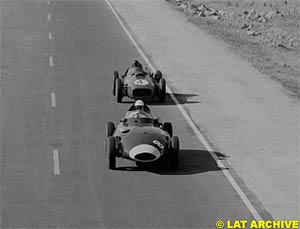 At the outset of the 1958 season, Moss took an early lead in the Drivers' Championship by winning the Grand Prix of Argentina in a triumph of racecraft over brute power. The Vanwall team did not make the long trip to Argentina so Moss was driving Rob Walker's rear-engined privateer Cooper-Climax. In the heat of Buenos Aires, Moss won the Grand Prix in a privateer rear-engined 1.9 litre Cooper-Climax by running the whole race without a pit stop on his thread-bare Continental tires while the more powerful 2.5 litre front-engined Ferrari's and Maserati 250F's were burning up the track but had to stop for fresh tires.
At the outset of the 1958 season, Moss took an early lead in the Drivers' Championship by winning the Grand Prix of Argentina in a triumph of racecraft over brute power. The Vanwall team did not make the long trip to Argentina so Moss was driving Rob Walker's rear-engined privateer Cooper-Climax. In the heat of Buenos Aires, Moss won the Grand Prix in a privateer rear-engined 1.9 litre Cooper-Climax by running the whole race without a pit stop on his thread-bare Continental tires while the more powerful 2.5 litre front-engined Ferrari's and Maserati 250F's were burning up the track but had to stop for fresh tires.
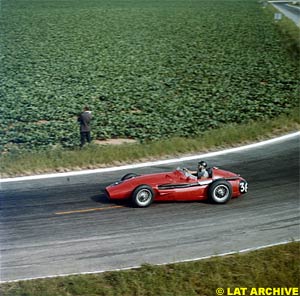 Hawthorn recalled in his biography the sensation of both his clutch and his Championship slipping away towards the end of the Monza race and his private thoughts at that anxious moment: "Phil [Hill] was catching me up now. By the last lap [my] car was hardly moving as I took the South Curve for the last time I saw [Phil] in my mirror, coming up fast. God, I thought, perhaps he does not realize it's me. So I put my arm out and frantically waved him down. Afterwards he told me he did not realize it was me until he saw the green sleeve of my jacket come out and wave at him."
Hawthorn recalled in his biography the sensation of both his clutch and his Championship slipping away towards the end of the Monza race and his private thoughts at that anxious moment: "Phil [Hill] was catching me up now. By the last lap [my] car was hardly moving as I took the South Curve for the last time I saw [Phil] in my mirror, coming up fast. God, I thought, perhaps he does not realize it's me. So I put my arm out and frantically waved him down. Afterwards he told me he did not realize it was me until he saw the green sleeve of my jacket come out and wave at him."
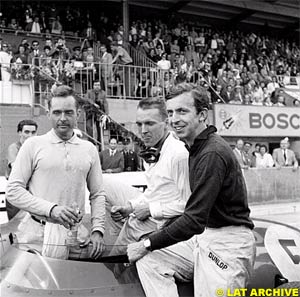 With the human costs of victory now in - Musso, Collins, Hawthorn - the 1959 Ferrari works team had a completely different look. Vanwall had closed its doors because of owner Tony Vandervell's health and other reasons and Tony Brooks had moved over to the Ferrari team, as did French star Jean Behra; at Phil Hill's suggestion, fellow American Dan Gurney also joined the Ferrari team for a few races. Incredibly, Phil Hill was now the senior man after all the carnage of the past season, in effect having been given a Battlefield Commission.
With the human costs of victory now in - Musso, Collins, Hawthorn - the 1959 Ferrari works team had a completely different look. Vanwall had closed its doors because of owner Tony Vandervell's health and other reasons and Tony Brooks had moved over to the Ferrari team, as did French star Jean Behra; at Phil Hill's suggestion, fellow American Dan Gurney also joined the Ferrari team for a few races. Incredibly, Phil Hill was now the senior man after all the carnage of the past season, in effect having been given a Battlefield Commission.
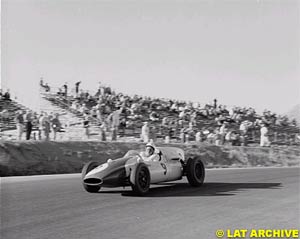 In the 1960 season, which was the last year of the 2.5 litre formula, Ferrari's cars stood still, while Cooper, Lotus and BRM improved their rear-engined cars. The results reflected the mechanical stagnation at Maranello. Indeed, the only decent showing by the Ferrari team in 1959 resulted from a home-grown anomaly, when the British teams decided to boycott the Monza race because of what they regarded as the dangerously bumpy Monza banking. The absence of British Racing Green permitted the aging Ferrari Dino 246s to finish 1, 2, 3 and 5. In winning the 1959 Italian Grand Prix, Phil Hill had the honor of achieving the last Grand Prix win ever in a front-engined car, the Ferrari Dino 246 warhorse, No. 20 .
In the 1960 season, which was the last year of the 2.5 litre formula, Ferrari's cars stood still, while Cooper, Lotus and BRM improved their rear-engined cars. The results reflected the mechanical stagnation at Maranello. Indeed, the only decent showing by the Ferrari team in 1959 resulted from a home-grown anomaly, when the British teams decided to boycott the Monza race because of what they regarded as the dangerously bumpy Monza banking. The absence of British Racing Green permitted the aging Ferrari Dino 246s to finish 1, 2, 3 and 5. In winning the 1959 Italian Grand Prix, Phil Hill had the honor of achieving the last Grand Prix win ever in a front-engined car, the Ferrari Dino 246 warhorse, No. 20 .
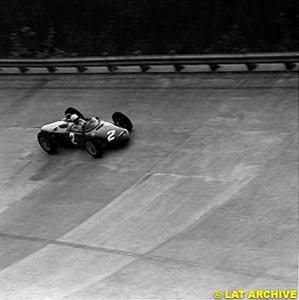 The only blot on the design was an almost comically weak-looking roll hoop, which looked light and ineffectual. After stubbornly resisting the rear-engined revolution begun by Cooper in 1959, (as his Indianapolis 500 counterparts would also do in years to come), Enzo Ferrari had been won over by his staff and commissioned a prototype rear-engined Ferrari in 1960, with an eye to the introduction of the car to coincide with the change to the 1.5 litre formula for 1961. The lithe and elegant looking Sharknose was the result, Ferrari's first rear-engined car and a winner right out of the box, taking first place in the Syracuse Grand Prix in Sicily, a non-Championship race run before the Grand Prix season began.
The only blot on the design was an almost comically weak-looking roll hoop, which looked light and ineffectual. After stubbornly resisting the rear-engined revolution begun by Cooper in 1959, (as his Indianapolis 500 counterparts would also do in years to come), Enzo Ferrari had been won over by his staff and commissioned a prototype rear-engined Ferrari in 1960, with an eye to the introduction of the car to coincide with the change to the 1.5 litre formula for 1961. The lithe and elegant looking Sharknose was the result, Ferrari's first rear-engined car and a winner right out of the box, taking first place in the Syracuse Grand Prix in Sicily, a non-Championship race run before the Grand Prix season began.
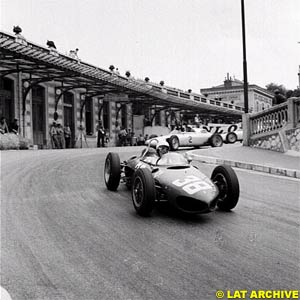 The British Grand Prix, which was held at Aintree near Liverpool in 1961, turned into a Sharknose Sweep, with von Trips, Phil Hill and Ginther finishing in that order, Phil Hill again on pole.
The British Grand Prix, which was held at Aintree near Liverpool in 1961, turned into a Sharknose Sweep, with von Trips, Phil Hill and Ginther finishing in that order, Phil Hill again on pole.
Next Week: Triumph and Tragedy at Monza
Please Contact Us for permission to republish this or any other material from Atlas F1.
|
Volume 7, Issue 39
Atlas F1 Exclusive
Exclusive Interview with Jo Ramirez
Articles
Phil Hill: Made in America
Picture Perfect
United States GP Preview
The United States Grand Prix Preview
Technical Preview: Indianapolis
Columns
Elsewhere in Racing
The US Grand Prix Circuit Trivia Quiz
Bookworm Critique
The Weekly Grapevine
> Homepage |